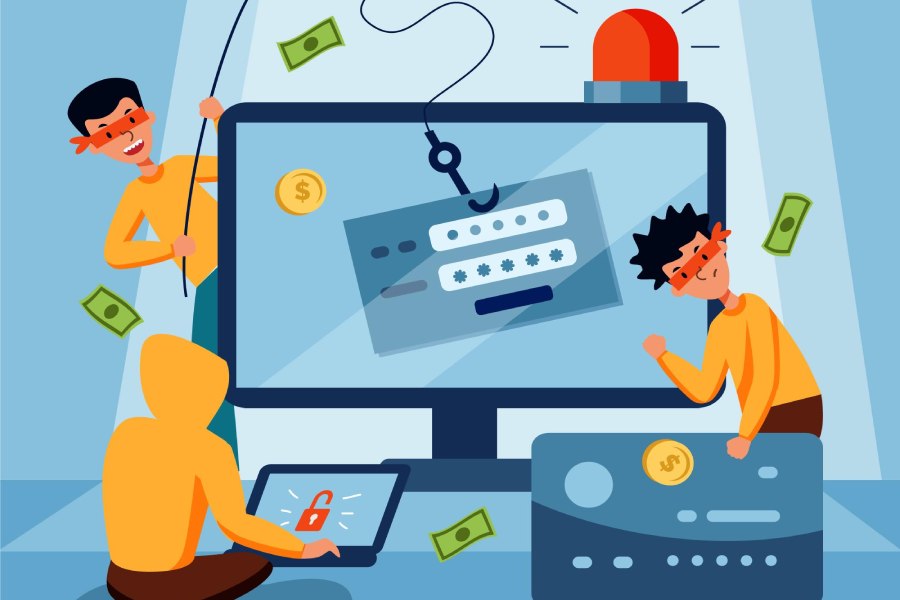The tax season for 2022 is underway, and individuals and businesses (especially SMBs) need to pay attention to the latest frauds surrounding taxes to safeguard their finances. Scam artists dupe people throughout the year, but this activity is higher during the tax season. This significant increase is due to lesser knowledge or fear around proper tax filing. Nevertheless, individuals need to keep an eye out for different types of scams.
Popular Scams During the Tax Season
There are a variety of services that fraudsters use to target your finances and personal information during the tax season, including:
- Unsolicited Texts Messages: Be alert if you receive a text message or a direct message on any social media platform. Scammers impersonating the IRS (Internal Revenue Service) may send you bogus texts regarding personal tax issues, bills, refunds, or ask for your personal information. These messages might also contain links to official-looking counterfeit websites with fake addresses and payment portals to dupe you out of your money. Please note that the IRS does not communicate via texts or social media platforms.
- Unemployment Scams & Identity Theft: Many individuals lost their livelihood to the pandemic, but scam artists are exploiting this situation by using stolen identities to receive unemployment compensation. Your stolen identity might be used in other states by fraudsters to file such claims, so be on the lookout to report if you receive an official email from a government agency or an employer regarding unemployment claims.
- Email Phishing: Email phishing is just like an unsolicited text, only this time the message is conveyed via an email with phishing links. These phishing links redirect to fake websites where you will be asked to enter personal information or make payments. The IRS does not send unsolicited emails requesting financial information. They use emails to convey overdue tax bills or returns which is why you should look out for emails that threaten action if some amount is not paid or ask for personal information for refund purposes.
- Telephone Impersonation: Calling out of the blue, impersonating an IRS official is another popular way scammers try to defraud you. Scammers impersonating IRS officers will try to scare you and demand taxes to be paid without question or even threaten arrest if their demand is not met. The IRS always sends a bill via mail and never asks for immediate payments using a particular method such as a credit card, digital asset, gift card, or more.
- SSN Scam: Fraudsters also use the SSN (Social Security Number) scam in the tax season. Scammers can call you or might use machine-generated messages to compel you to pay a certain amount or tax bill within some stipulated time and threaten to suspend your SSN if the payment is not made. You should avoid such messages and avoid sharing sensitive information over phone calls.
University staff and students should also be on the lookout since this year can repeat a popular scam from last year, highlighted by the IRS where university professors and students received unsolicited emails impersonating the IRS for tax refunds and recalculations. These emails were accompanied by phishing links that requested personal information such as SSN, name, date of birth, income, address, state, and more.
You can learn more about the latest scams and reports on the IRS’s newsroom for consumer alerts.
How to Identify and Avoid IRS Impersonators and Tax Scams
Before learning how to identify fraudsters, you must understand some basic principles of the IRS:
- The IRS does not threaten
- The IRS does not limit or demand particular payment methods
- The IRS does not require or demand immediate payment
If you come across any phone call, text, or email in this regard, you will know you are being scammed. Furthermore, there are easy ways, common to all scams that fraudsters use to defraud you during the tax season, such as:
- Never share personal information over calls or unsolicited messages via texts or social media.
- Avoid or report unsolicited email and messaging activity
- Avoid payment links shared via these sources.
- In case an email or text redirects you to a website, check its legitimacy. Counterfeit websites often contain minor spelling mistakes.
- Confirm the payment portal, method, or number on the IRS’s website
- Avoid sharing personal information or payment details over the phone without verifying the identity of the caller
- If you receive machine-generated messages or calls asking to pay tax bills or share account information, hang up and report the number.
- If a scammer wants personal information regarding the refund of taxes, you should check the status before sharing such information on the IRS’s refund page.
How to Report Tax Fraud Activity
Tax fraud activity will continue and rise unless the whole community takes the initiative to report fraudsters. It should be a personal duty to report scam emails and phone numbers so that you can keep your fellow citizens safe.
- The IRS has provided its email, phishing@irs.gov, where you can report unsolicited or scam emails.
- You can report tax scams, crimes, or IRS employ misconducts on the US Treasury’s report crime page.
- For more information on reporting tax scams, you can visit this page.
Final words
The tax season will continue till the mid of April for most individuals, which means there are a few months that you need to be on alert for scam artists targeting you with tax-related scams. Tax scams are on the rise, and you are likely to receive one or more unsolicited calls or texts, threatening action for unpaid dues or asking for personal information. You should follow the steps provided above to safeguard your funds and personal information and be on the lookout for fraudsters. It is especially crucial for businesses to educate their employees about these scams, as threat actors also use this as an opportunity to infiltrate your business’ information assets and launch further cyber-attacks.


